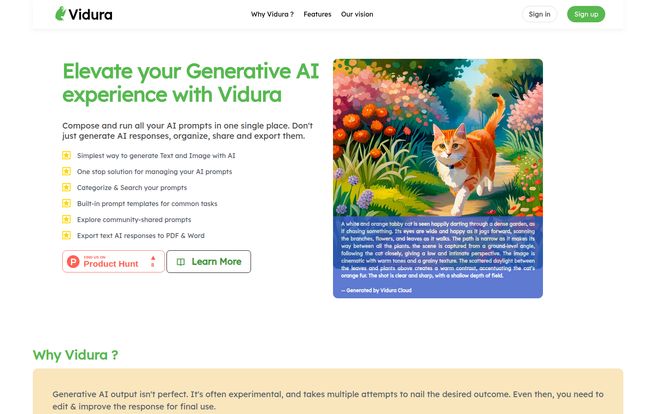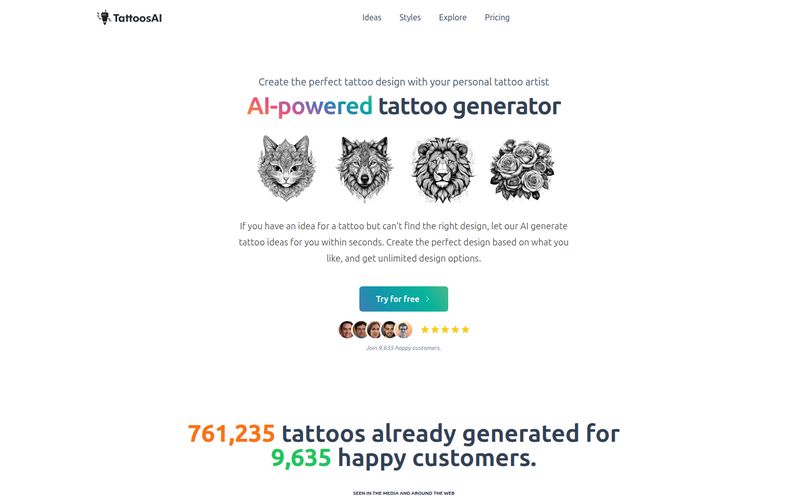If you’re like me, your current AI prompt management system is... well, it’s a system in the loosest sense of the word. It's a chaotic mix of a forgotten Google Doc, a dozen open Notepad files, a few notes scribbled on a real-life sticky note that’s lost its stick, and the faint memory of a brilliant prompt you used three weeks ago but can never seem to recreate.
We’ve all been there. Spending an hour wrestling with Midjourney, changing one word at a time, trying to get it to generate a cat that doesn’t have the eyes of a Lovecraftian horror. Or tweaking a GPT-4 prompt over and over to get the tone just right for a client’s blog post. This process, this “prompt-and-pray” method, is exhausting. It's the messy, unglamorous side of the AI revolution.
So when I heard about Vidura, a platform that calls itself a “prompt manager for generative AI,” my ears perked up. The name itself is a great start—in Sanskrit, it means “wise” or “skilled.” And boy, do I want to feel wiser when I’m staring down the barrel of another blank prompt box. But is it just another tool in an already crowded space, or is it the solution to our collective digital mess?
I decided to take a look.

Visit Vidura AI
First Off, What Is a Prompt Manager and Why Should You Care?
Before we get into Vidura itself, let's talk about the 'why'. For the past couple of years, we've been so focused on what generative AI can do that we've mostly ignored how we do it. The craft of writing a good prompt—often called prompt engineering—is a genuine skill. But managing those prompts? That's been an afterthought.
Imagine trying to run a professional kitchen, but all your recipes are scattered on random scraps of paper, some stained with sauce, some lost behind the oven. That’s what most of us are doing with our prompts. A prompt manager is the professional recipe book. It’s the organized, indexed, and tested source of truth. It's the difference between a messy garage where you can never find the right screwdriver and a professional workshop where every tool has its place.
A Closer Look at Vidura's Toolkit
From what I've seen on their site, Vidura isn't just a fancy notepad. It's aiming to be a full-blown productivity platform for anyone who works with AI regularly. It's built around several key ideas that directly address the pain points I feel every single day.
Taming the Beast with Categories and Templates
The first thing that caught my eye was the ability to create categories for your AI prompts. Simple, right? But revolutionary in practice. I can already picture it: a folder for “Blog Post Intros,” another for “PPC Ad Copy,” and a special, top-secret folder for “Snarky Email Responses.” Being able to organize prompts by project, client, or function is a foundational step toward sanity.
Vidura also pushes the idea of “Quick Templates” for text or image prompts. This is more than just copy-pasting. It’s about building a starting point, a reusable framework you can build upon. It's about creating consistency in your outputs, which is critical for anyone trying to maintain a specific brand voice or artistic style.
The Real Magic of Dynamic Prompting
This is where things get really interesting for me as an SEO. Vidura features “Dynamic Prompting,” which looks like their term for using variables in your prompts. This is a massive time-saver. Think about it: you can create one killer prompt for generating meta descriptions and just plug in variables like [Product Name], [Key Feature], or [Target Audience].
You write the core logic once and then reuse it endlessly. It turns a repetitive task into a simple, form-fill exercise. For content marketers, social media managers, and SEOs, this feature alone could be worth its weight in gold. It’s about working smarter, not just harder.
Your Personal AI Time Machine with Prompt Run History
I think this might be my favorite feature. Vidura keeps an “Audit Prompt History,” letting you compare different runs of a prompt side-by-side. This is absolutely critical for learning and refinement.
How many times have you tweaked a prompt, gotten a worse result, and then couldn't remember the exact wording of the previous, better version? It's maddening. Having a run history is like having version control for your creativity. It’s the Git for your GPT. You can see what you changed, what the output was, and make informed decisions about your next attempt. It turns frustrating guesswork into a data-driven process.
More Than a Tool, It’s a Community (Apparently)
Vidura also includes a community-driven platform for sharing and discovering prompts. There’s even a leaderboard, which adds a little gamification to the mix. I have mixed feelings about community prompts, if I'm being honest. It can be a bit of a potluck—sometimes you find a gourmet dish, other times you find a questionable jello salad.
However, the value here is in learning. Seeing how other people structure their prompts, especially for complex tasks, can spark new ideas and help you get past a creative block. You don't have to use their prompts verbatim, but you can certainly learn from their techniques.
Secure Sharing for Teams and Agencies
For those of us not working in a vacuum, the “Share Prompts Securely with Selected User Groups” feature is a big deal. If you're part of an agency or an in-house marketing team, you need to ensure everyone is pulling in the same direction. Sharing a set of approved, on-brand prompts means the whole team can generate consistent content without constant oversight. It helps scale quality, which is the holy grail of content production.
So, What's the Catch? A Realistic View
No tool is perfect, and it's important to go in with open eyes. Based on the info, and just my general experience with new platforms, here are a few things to consider.
Some will argue that the AI's output is still the main event, and a manager just adds another layer. They're not wrong. Vidura won't magically make ChatGPT a better writer or Midjourney a better artist. It’s a tool to manage the process. It cleans up your workshop; it doesn’t swing the hammer for you. You still need to edit, refine, and add that human touch to the final product.
There might also be a slight learning curve. Any powerful tool requires a bit of upfront investment to learn its features, like Dynamic Prompting. It won't be as simple as opening a text file, but the payoff in efficiency should make it worthwhile.
What's the Damage? Vidura Pricing
As of right now, I couldn't find any specific pricing information on their website. This is pretty common for new platforms in beta or just launching. They're likely still figuring out their tiers and offerings. My guess is we might see a freemium model with a limited number of prompts and a pro/team tier with all the bells and whistles like secure sharing and unlimited history. For the most current details, you'll have to check their official site.
Frequently Asked Questions about Vidura
What exactly is Vidura?
Vidura is a cloud-based platform designed to help you write, manage, organize, and test your prompts for various generative AI systems, including text, image, speech, and music generators.
What AI systems does it work with?
The platform is designed to be a central hub, integrating with multiple AI systems. This means you can manage your prompts for tools like GPT, Claude, Midjourney, and others all in one place, rather than having them scattered across different platforms.
Is Vidura better for individuals or for teams?
It seems designed for both. An individual can get a ton of value from the organization, history, and dynamic prompting features. For teams and agencies, the secure sharing via User Groups is a standout feature for maintaining brand consistency and collaboration.
Is it difficult to learn?
Basic features like organizing prompts into categories should be intuitive. More advanced features like Dynamic Prompting will likely require a little practice to master, like any powerful software. But the potential time-savings make it a worthy investment.
Why not just use a text file or a spreadsheet?
You can, but you'd miss out on the core benefits. A spreadsheet can't track your prompt run history, let you easily test variables with dynamic prompting, integrate directly with AIs, or provide a community to learn from. Vidura is built specifically for teh workflow of using generative AI.
My Final Thoughts
I'm cautiously optimistic about Vidura. The world of generative AI is still the Wild West, and we desperately need some sheriffs to bring a little order to town. A dedicated prompt manager isn't just a 'nice-to-have' anymore; for professionals, it's quickly becoming a necessity.
By focusing on organization, testing, and collaboration, Vidura is addressing a real, tangible need in the market. It’s a sign that the industry is maturing, moving from pure novelty to sustainable productivity. It's a tool that acknowledges that the human behind the AI is just as important as the model itself. And for that, I'm definitely keeping it on my radar.
Reference and Sources
- Vidura Official Website: https://vidura.ai/



